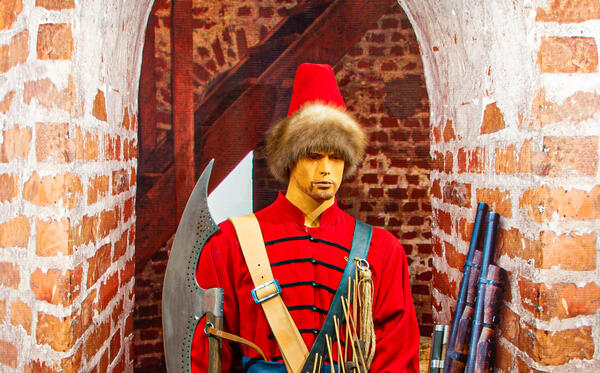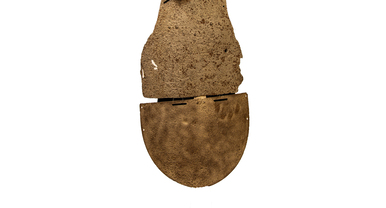Originally, all the archers of the Russian medieval army were called streltsy. However, in 1550, only those who joined the regular Russian infantry could be so called. The first streletskoye voysko (firearm infantry) was made up of pishchal’niki — soldiers armed with arquebuses (pishchal in Russian). The army consisted of 3,000 men, who were divided into six “units” (prikazi) of 500 men each.
On May 25, 1525 by the order of Vasily III, Grand Prince of Moscow, the construction of the stone-and-brick Kolomna Kremlin began. Six years later it was completed. Almost two kilometers long walls enclosed 24 hectares of land on which the Kremlin was located. There were 16 towers along the perimeter, three of which had passage gates, and a secret depositary.
Streltsy served in the Kolomna Kremlin; the appearance of a strelets warrior has been reconstructed for the museum’s exposition. The banner of a mounted regiment flies above him. Their most common weapons were foreign-made muskets or pishchal guns.
Streltsy wore a belt — a berendeika — over their shoulders. Attached to it were a powder flask, a bullet bag, a slow match for the gun, and wooden cases for gunpowder, which were called ‘zaryadcy’ (filling powder flasks). Each filling flask contained the exact amount of gunpowder for one single shot.
The military service for streltsy was largely hereditary. Streltsy were paid an annual salary and were exempted from paying taxes. In addition to service, they could engage in crafts or trade. The prikazi (units), to which the streltsy were assigned, were called by the names of their commanders and had serial numbers. The regiments were given a number, starting with one, in each town. It was believed that the smaller the number was, the greater the honor the regiment deserved.
Within the municipal streltsy, there were regiments with soldiers mounted on horses, but we cannot call them cavalry in the full sense of the word: they were simply mounted infantry. The command staff of the prikaz (unit) was called ‘nachalnye ludi’ (the primary men). It consisted of a golova (tysyatskiy — group leader of one thousand men), a half-golova (polugolova — leader of 500 men), as well as sotniks (leader of 100 men) and uriadniks (or desyatniks — leader of 10 men).
Under the rule of Ivan the Terrible the number of strelets troops stood at 7 thousand, two thousands of them were mounted. 8 golovas and 41 sotniks were in charge of the units. By the end of his reign, there were 12 thousand streltsy, and by the time of the coronation of Fyodor Ioannovich in the summer of 1584 there were 20 thousand.
On May 25, 1525 by the order of Vasily III, Grand Prince of Moscow, the construction of the stone-and-brick Kolomna Kremlin began. Six years later it was completed. Almost two kilometers long walls enclosed 24 hectares of land on which the Kremlin was located. There were 16 towers along the perimeter, three of which had passage gates, and a secret depositary.
Streltsy served in the Kolomna Kremlin; the appearance of a strelets warrior has been reconstructed for the museum’s exposition. The banner of a mounted regiment flies above him. Their most common weapons were foreign-made muskets or pishchal guns.
Streltsy wore a belt — a berendeika — over their shoulders. Attached to it were a powder flask, a bullet bag, a slow match for the gun, and wooden cases for gunpowder, which were called ‘zaryadcy’ (filling powder flasks). Each filling flask contained the exact amount of gunpowder for one single shot.
The military service for streltsy was largely hereditary. Streltsy were paid an annual salary and were exempted from paying taxes. In addition to service, they could engage in crafts or trade. The prikazi (units), to which the streltsy were assigned, were called by the names of their commanders and had serial numbers. The regiments were given a number, starting with one, in each town. It was believed that the smaller the number was, the greater the honor the regiment deserved.
Within the municipal streltsy, there were regiments with soldiers mounted on horses, but we cannot call them cavalry in the full sense of the word: they were simply mounted infantry. The command staff of the prikaz (unit) was called ‘nachalnye ludi’ (the primary men). It consisted of a golova (tysyatskiy — group leader of one thousand men), a half-golova (polugolova — leader of 500 men), as well as sotniks (leader of 100 men) and uriadniks (or desyatniks — leader of 10 men).
Under the rule of Ivan the Terrible the number of strelets troops stood at 7 thousand, two thousands of them were mounted. 8 golovas and 41 sotniks were in charge of the units. By the end of his reign, there were 12 thousand streltsy, and by the time of the coronation of Fyodor Ioannovich in the summer of 1584 there were 20 thousand.
In 1683, the prikazi were reorganized and became known as polki, which consisted of regiments of 100 men.
Besides the Moscow regiments, there were also gorodskiye streltsy (municipal regiments in many Russian towns). Peter the Great abolished the Moscow Streltsy troops in 1711, but the several municipal regiments existed until 1716.



